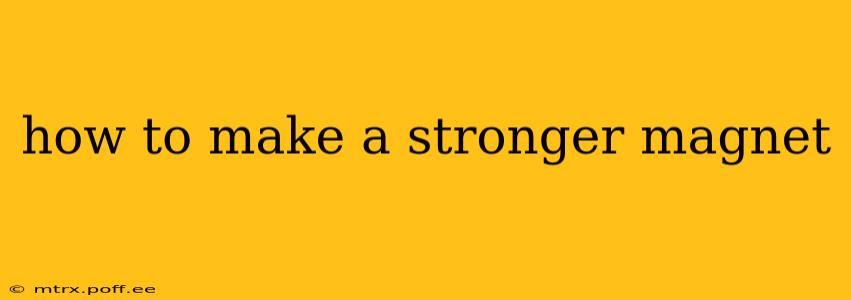How to Make a Stronger Magnet: A Comprehensive Guide
Creating stronger magnets isn't about simple tricks; it's about understanding the science behind magnetism and employing specific techniques. This guide delves into the methods and considerations for enhancing the magnetic strength of existing magnets or creating new, more powerful ones.
What Makes a Magnet Strong?
The strength of a magnet, also known as its magnetic field strength, is primarily determined by several factors:
-
Material: Certain materials are inherently more magnetic than others. Rare-earth magnets, like neodymium (NdFeB), samarium cobalt (SmCo), and alnico, are known for their exceptional magnetic strength. Ferrite magnets are a more common, less expensive alternative, but generally weaker. The specific composition and manufacturing process of the material significantly impact its magnetic properties.
-
Size and Shape: A larger magnet generally has a stronger field than a smaller one, assuming the material is the same. The shape also plays a role; certain geometries, such as cylindrical or toroidal shapes, can concentrate the magnetic field, making them appear stronger in certain areas.
-
Magnetization Process: The way a magnet is magnetized greatly affects its strength. A stronger magnetizing field during manufacturing results in a more powerfully magnetized magnet. This process often involves powerful electromagnets.
-
Temperature: The magnetic properties of most magnets are temperature-dependent. Exposure to high temperatures can weaken or even demagnetize a magnet, a process known as magnetic demagnetization.
Can You Make an Existing Magnet Stronger?
While you can't fundamentally change the material of an existing magnet, you can sometimes enhance its apparent strength:
-
Remagnetization: If a magnet has weakened over time, carefully remagnetizing it using a stronger magnet or electromagnet can restore some of its strength. However, this won't exceed the original magnetization level. Caution: Improper remagnetization can damage the magnet.
-
Optimal Arrangement: Positioning multiple magnets strategically can create a stronger combined magnetic field in certain areas. Experiment with different arrangements and orientations to maximize the field in the desired location.
How Are Powerful Magnets Made?
The creation of strong magnets is a complex manufacturing process, not something easily replicated at home. It generally involves:
-
Material Selection: Choosing the appropriate magnetic material (neodymium, samarium cobalt, etc.) based on the desired strength, temperature stability, and cost.
-
Sintering or Casting: For rare-earth magnets, a sintering process is used, involving high-temperature heating and pressing of the powdered material. Alnico magnets are often cast.
-
Magnetization: A powerful electromagnet is used to apply a high-intensity magnetic field to the material, aligning the magnetic domains and creating a permanent magnet. The strength of this field directly impacts the final magnet's strength.
Can I Make a Strong Magnet at Home?
Creating a truly strong magnet from scratch at home is impractical due to the specialized equipment required for the manufacturing process. However, you can create weaker magnets using simple methods, like stroking a piece of iron with a strong magnet repeatedly in one direction. This aligns the magnetic domains within the iron, creating a temporary magnet. This method will not produce a magnet with the strength of commercially available magnets.
What are the Different Types of Strong Magnets?
There are several types of strong magnets, each with its own advantages and disadvantages:
-
Neodymium Magnets (NdFeB): The strongest type of permanent magnet currently available, offering excellent strength-to-weight ratios. However, they are susceptible to corrosion and can lose strength at high temperatures.
-
Samarium Cobalt Magnets (SmCo): These magnets are more resistant to high temperatures and corrosion than neodymium magnets but are generally less strong and more expensive.
-
Alnico Magnets: Offer good temperature stability and resistance to demagnetization, but are weaker than neodymium and samarium cobalt magnets.
How Can I Protect a Strong Magnet From Losing Its Strength?
To maintain the strength of your magnets:
-
Avoid High Temperatures: Excessive heat can weaken or demagnetize magnets.
-
Store Properly: Keep magnets away from other magnets that could potentially demagnetize them. Store them in a protective case or container.
-
Prevent Corrosion: For magnets susceptible to corrosion (like neodymium magnets), consider applying a protective coating.
By understanding the principles behind magnetic strength and the manufacturing processes involved, you can appreciate the complexity of creating powerful magnets. While enhancing an existing magnet's strength might be achievable through remagnetization or strategic arrangement, making a truly strong magnet from scratch requires specialized equipment and expertise.
